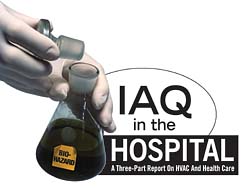
TAMPA, Fla. - When hospital employees were found to have a greater chance of developing adult-onset asthma, it was assumed that it was being caused by allergic responses to latex from gloves. Particulate from the gloves tends to enter the airstream. This may not be the case, according to Michael Hodgson, M.D., Ph.D., with the Veteran's Administration (VA), who spoke at the American Society of Heating, Refrigerating, and Air-Conditioning Engineers (ASHRAE) and the American Society for Healthcare Engineering (ASHE) 2004 IAQ conference. The meeting dealt with IAQ in hospitals.
Not too long ago, Hodgson "joined the world of operations, which is a very humbling thing for an academic to do," he admitted.
Then he challenged the audience: "What do we know now [about hospital IAQ] that we didn't five years ago? What have we learned about system interactions? Do we reward the right things?"

Symptoms And Possible Causes
Hodgson discussed asthma and its symptoms, moisture and mycotoxins, construction and bioaerosols, and infections.According to the third National Health and Nutrition Examination Survey (NHANES III), hospitals have the highest asthma rate among employers in North America, Hodgson said; 14.4 percent of health care workers have building-related asthma. Approximately 15 percent to 20 percent of asthma in adults is work related, he said. "More than 10 percent is building related.
"People have considered latex a primary driver," of medical field asthma, he continued.
The NHANES III report points out that less than 1.5 percent of these people have asthma that is related to latex.
Other irritants, such as gluteraldehyde and photo development chemicals, have been addressed. "We have not addressed moisture and bioaerosols."
There needs to be increased recognition and management of mold-related illness, Hodgson stated.
Furthermore, "If you encounter a problem, don't assume your contract providers know what they are talking about."
Gather independent data. When patients show up with symptoms and there seems to be a work relationship, look to an infrastructure assessment.

What Mold Does
Hodgson explained the mold and mycotoxins can cause asthma (worsening or new), hypersensitivity pneumonia, interstitial lung disease, sarcoidosis, and hemorrhagic pneumonia in some segments of the population - particularly those who are patients in hospitals, the weak, and the sick."We also need to ask if there are home problems too," he said. Specifically:
"Do we know how to control moisture in a health care environment?" Hodgson asked. "We recognize that reactive agents, such as nitrogen oxides and ozone, will cause mucosal irritation, will react with automotive exhaust."
As far as susceptibility, "Not everybody is the same," he pointed out. There are atopic individuals (people with a hereditary predisposition toward developing certain hypersensitivity reactions, such as hay fever, asthma, or chronic urticaria [hives] after exposure to specific antigens).
Post-menopausal women are also more susceptible to mucosal irritation because of the effects of hormone changes.
The average age of a nurse is 49, Hodgson pointed out.
"My perception of susceptible population has changed dramatically."
Air And Water
"We don't distinguish between irritation and infection," he said. "Infections do occur." Tuberculosis infections often occur because of ventilation failures, he stated. Lower ventilation rates and lower humidity are associated with more episodes of infections being passed around in offices.On the other hand, buildings with humidification have twice as many instances of chest tightness, he said.
Is it caused by the moisture? Re-searchers are not sure.
Case control studies show a relationship between high occupational moisture and bioaerosols for occupations such as farmers and metal workers.
"We need to think about moisture a lot differently," Hodgson said.
Construction and bioaerosols also need to be examined more closely. Several speakers pointed out that aspergillus is released during construction, with the generation of dust. During these times, there is a higher risk of bioaerosol exposure for areas of the hospital that still may be open during renovation.
Structured Communication
Guidelines from the Joint Commission on Accreditation of Healthcare Organizations (JCAHO) spell out the following communication protocols for low-, moderate-, and high-risk construction/renovation situations:Low risk: Provide verbal communication; take appropriate general measures.
Moderate risk: Provide verbal communication; include planning and dust control measures.
High risk: Provide written as well as verbal communication. Include infection control professionals who can shut down a project if necessary.
"Infections are related to ventilation," Hodgson pointed out. The less outdoor air brought in, the more infection there tends to be. Barrier precautions already in place include hand washing and wearing masks to prevent airborne infection spread through droplets released by coughing and sneezing.
Recirculation of infectious agents through ductwork is a big problem, Hodgson said. Nursing homes have a known risk of patient deaths due to influenza outbreaks, although there are no studies to confirm this, he said.
Ventilation And Moisture
Summing up, Hodgson said it is critical to follow recommended ventilation rates for hospitals. Studies have shown a positive correlation of increased symptoms with increased airborne irritants, allergies, and infectious agents.Higher moisture levels also are associated with increased symptoms. If a hospital is in a more humid zone, bringing in increased amounts of outside air could do more harm than good if the air is not treated for humidity control.
Engineers and building staff may say, "There's not enough money to do this," Hodgson said. However, he stated, management often is not aware of the consequences of a limited HVAC scope. Make them aware and the situation may change for the better.
Publication date: 05/24/2004



